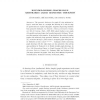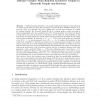736 search results - page 5 / 148 » Distinguishing geometric graphs |
TCSV
2008
13 years 8 months ago
2008
Object tracking is one of the fundamental problems in computer vision and has received considerable attention in the past two decades. The success of a tracking algorithm relies on...
COMBINATORICS
2007
13 years 8 months ago
2007
The distinguishing number ∆(X) of a graph X is the least positive integer n for which there exists a function f : V (X) → {0, 1, 2, · · · , n−1} such that no nonidentity ...
COMBINATORICS
2006
13 years 8 months ago
2006
Abstract. The geometric thickness of a graph G is the minimum integer k such that there is a straight line drawing of G with its edge set partitioned into k plane subgraphs. Eppste...
COMGEO
2011
ACM
13 years 3 months ago
2011
ACM
Let P be a set of n points in the plane. A geometric proximity graph on P is a graph where two points are connected by a straight-line segment if they satisfy some prescribed prox...
DIALM
2008
ACM
13 years 10 months ago
2008
ACM
A random geometric graph G(n, r) is a graph resulting from placing n points uniformly at random on the unit area disk, and connecting two points iff their Euclidean distance is at ...


